Fiordland National Park in New Zealand contains some of the most rugged wilderness in the world: impassable mountains, cartoonishly-dense rainforests, glaciers, and fjords fill the landscape there, allowing the intrepid traveler to enjoy a solitary, personal experience with nature like no other. But truth be told, I’d only ever been to front-country destinations in the park, like the world-famous Milford Sound. So when I had two days to kill before leading a New Zealand Photography Tour, I decided to strap on my trusty backpack and trek up into the Mistake Creek area of the park. Little did I realize I’d never make it there, getting waylaid by other entrancing adventures…
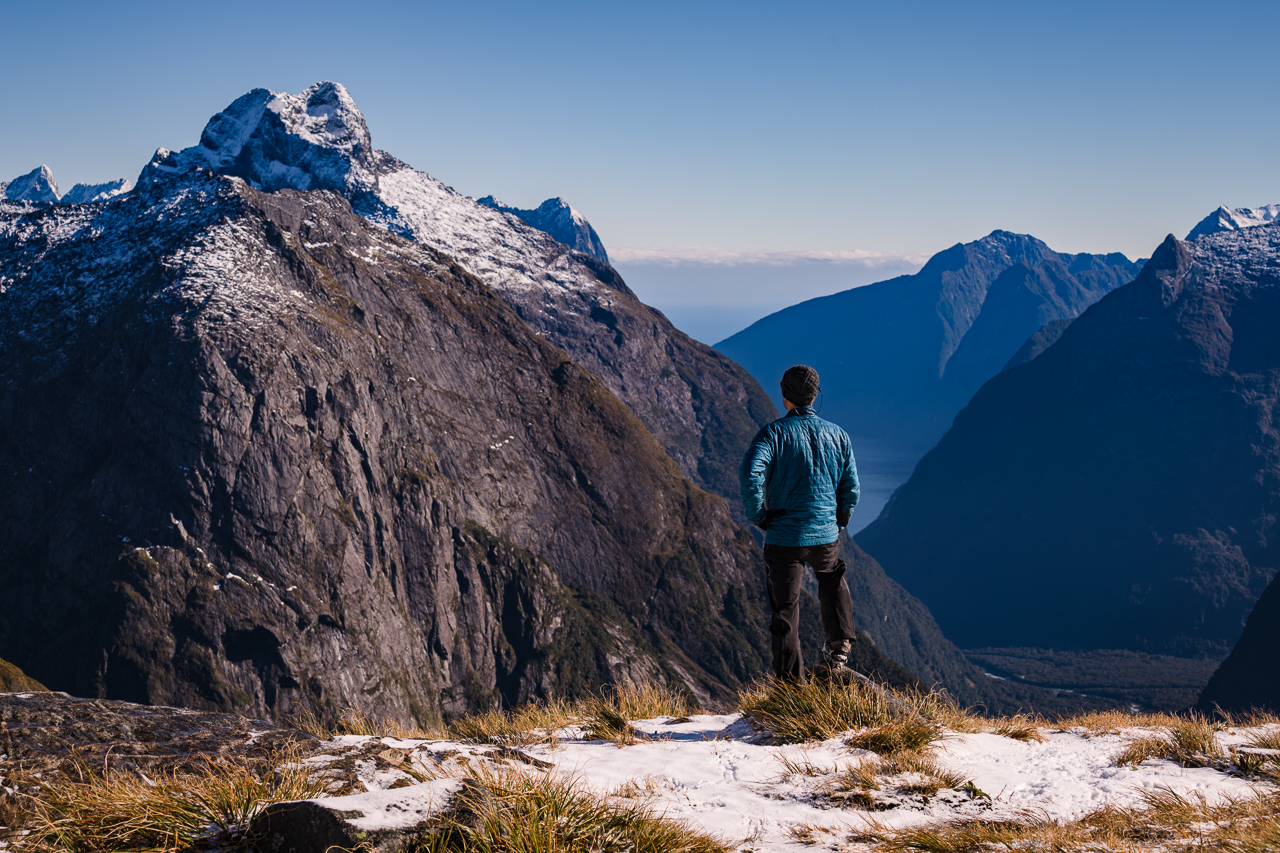
On the morning I intended to start my hike, I woke up in Te Anau, feeling refreshed and invigorated after seeing the Aurora Australis appear over the lake the night before. Unfortunately, the cloud cover was too thick to get anything but documentation photos of the phenomenon. But the weather gods were feeling generous and blessed the morning with a double rainbow over the lake. In fact, as I drove toward the park, the rainbow followed me for a good 30 minutes.
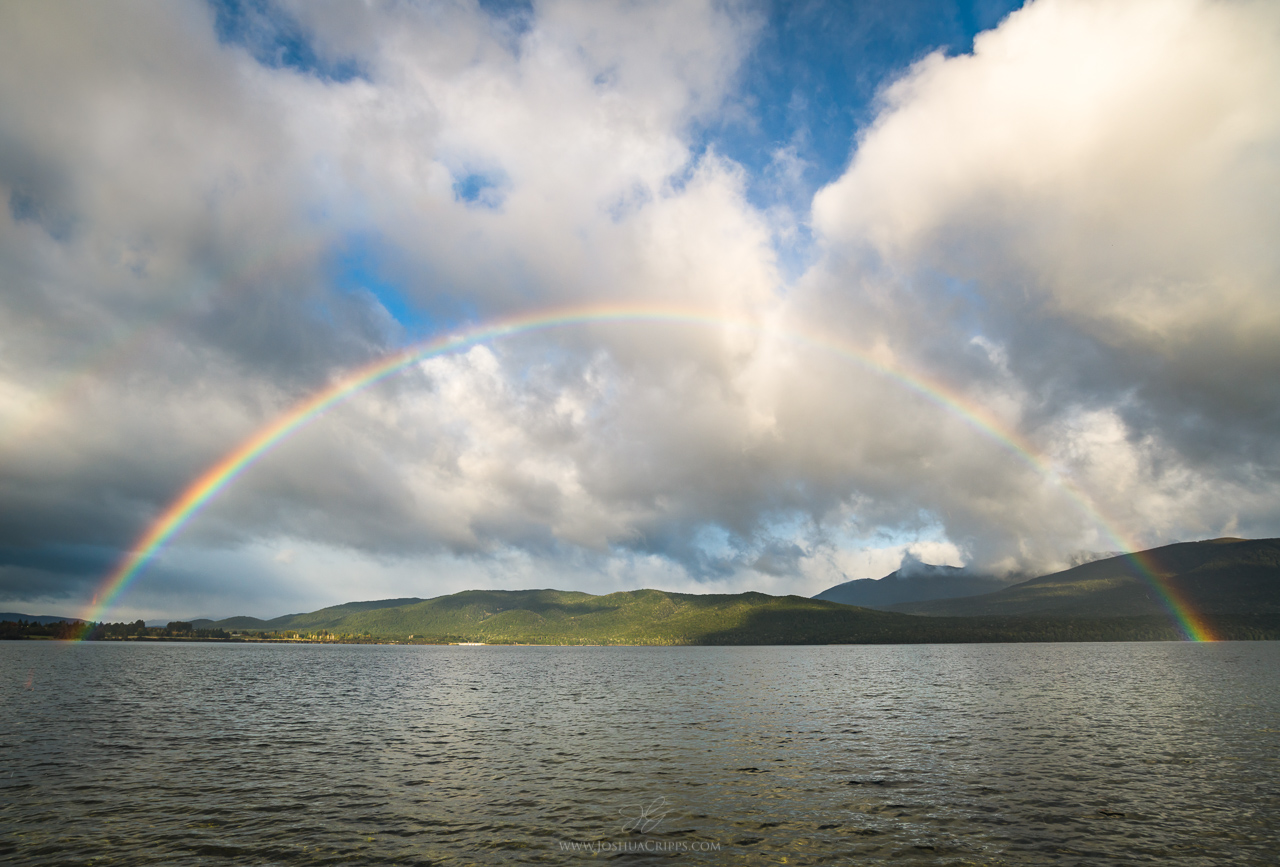
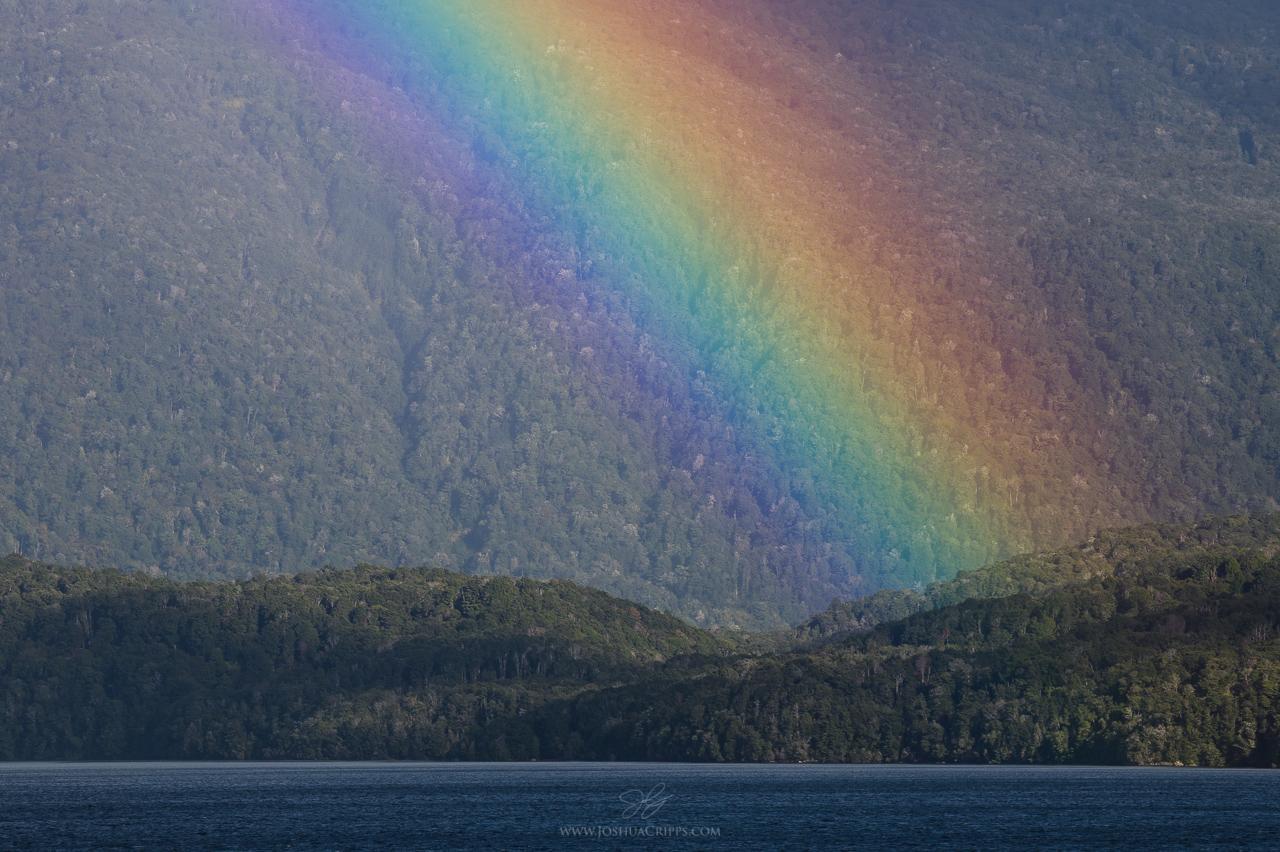
The road to Fiordland follows the shoreline of Lake Te Anau until it reaches Te Anau Downs, where it veers inland. From there, it winds its way past paddocks, trees, and farms until it rounds a bend and gives you a fantastic view into the Upper Eglinton Valley. As I came around said bend in my rental car, I screeched to a halt on the side of the road. Laid out before me was the front of the storm that created my morning rainbows. The day was fairly warm and as the storm retreated farther into the valley, billowing clouds of moisture plumed up from the ground. Sunlight penetrated the thinning cloud cover at the same time, leading to one of the most impressive displays of atmospheric crepuscular rays I’ve seen.
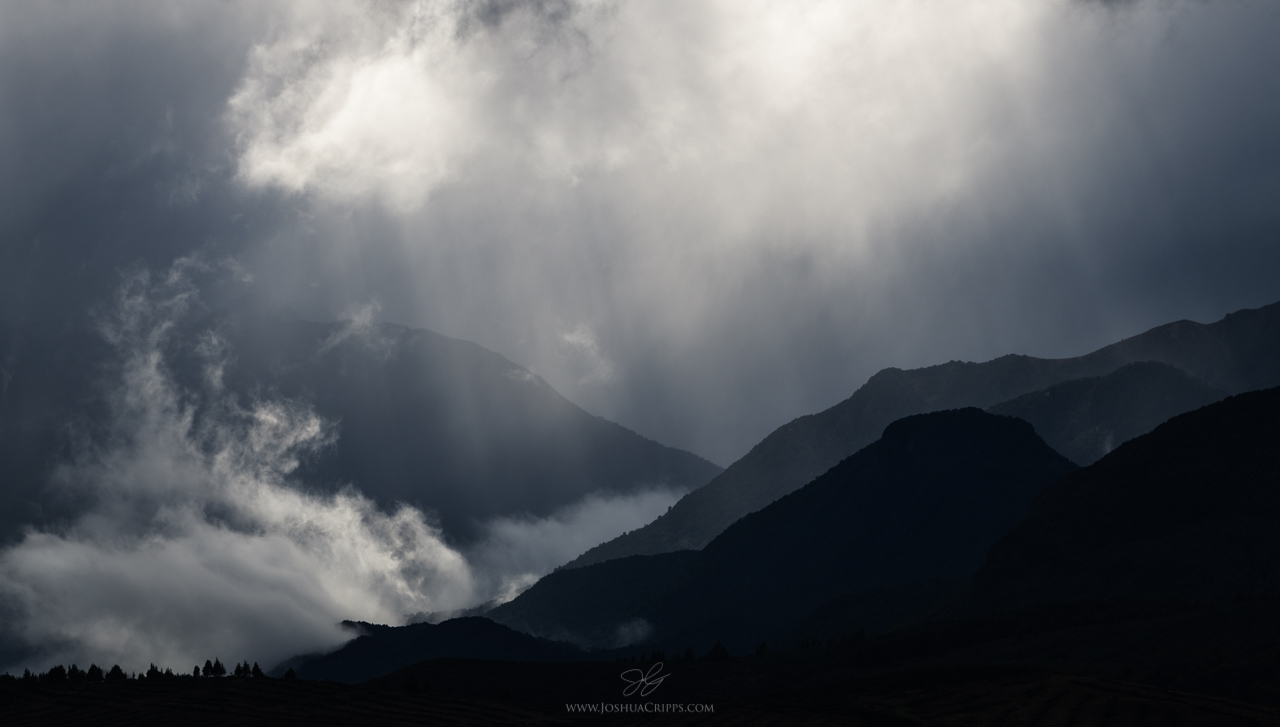
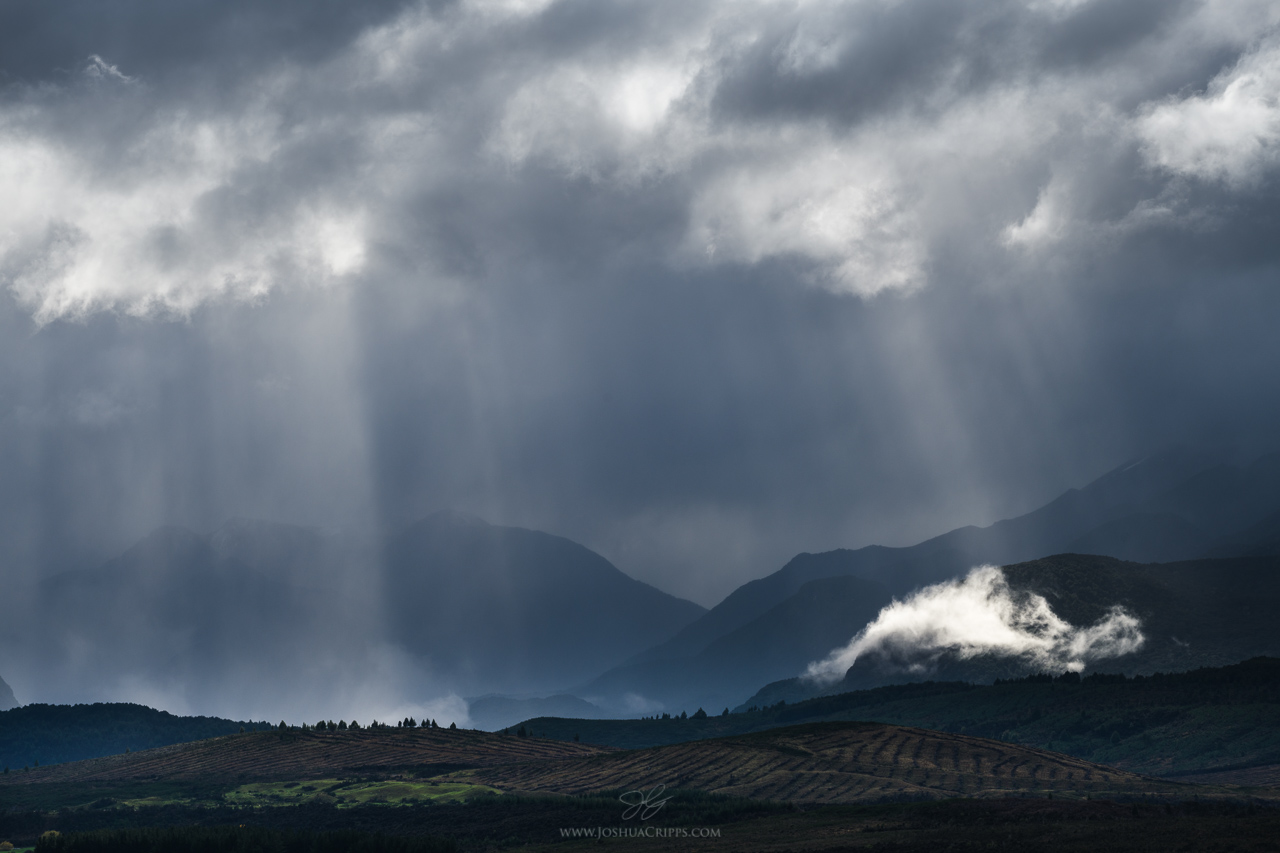
I photographed for a while but then hopped back in the car, eager to begin my hike. As I drove into the park, the first splatters of rain hit my windshield and soon I was under a full-on downpour. The storm was meant to break up as the day wore on, so I wasn’t worried about the weather. In fact, I timed my arrival at the trailhead to give me an hour in which to eat lunch and take a quick nap in the car before the skies cleared. Yet the rain continued to pour downward. I had given myself a cut-off time of 3 pm to start the hike, and as it drew nearer without any slack in the precipitation, I began to have second thoughts. Weather in Fiordland is notoriously fickle, and the fact that this storm wasn’t following the forecast didn’t mean much. It could break later in the day, or turn the other direction and rain harder. Most days, I don’t mind hiking in the rain; I’m happy to put on my big boy pants and go splashing off down the trail. But on that day, for whatever reason, I just wasn’t feeling up to it, so I scuttled my backpacking plans and retreated a few kilometers down the road to the Upper Eglinton campsite.
The nice thing about rain is that it keeps most people away, meaning that as I pitched my tent on the least soggy patch of ground in the camping area, I was the only person around. Around the same time, the storm actually did begin to break up, but rather than dash back to the trailhead for an overnight trek, I opted to have a relaxing afternoon of car camping and photographing the clouds, rain, sun, and mountains as they all danced and played together.
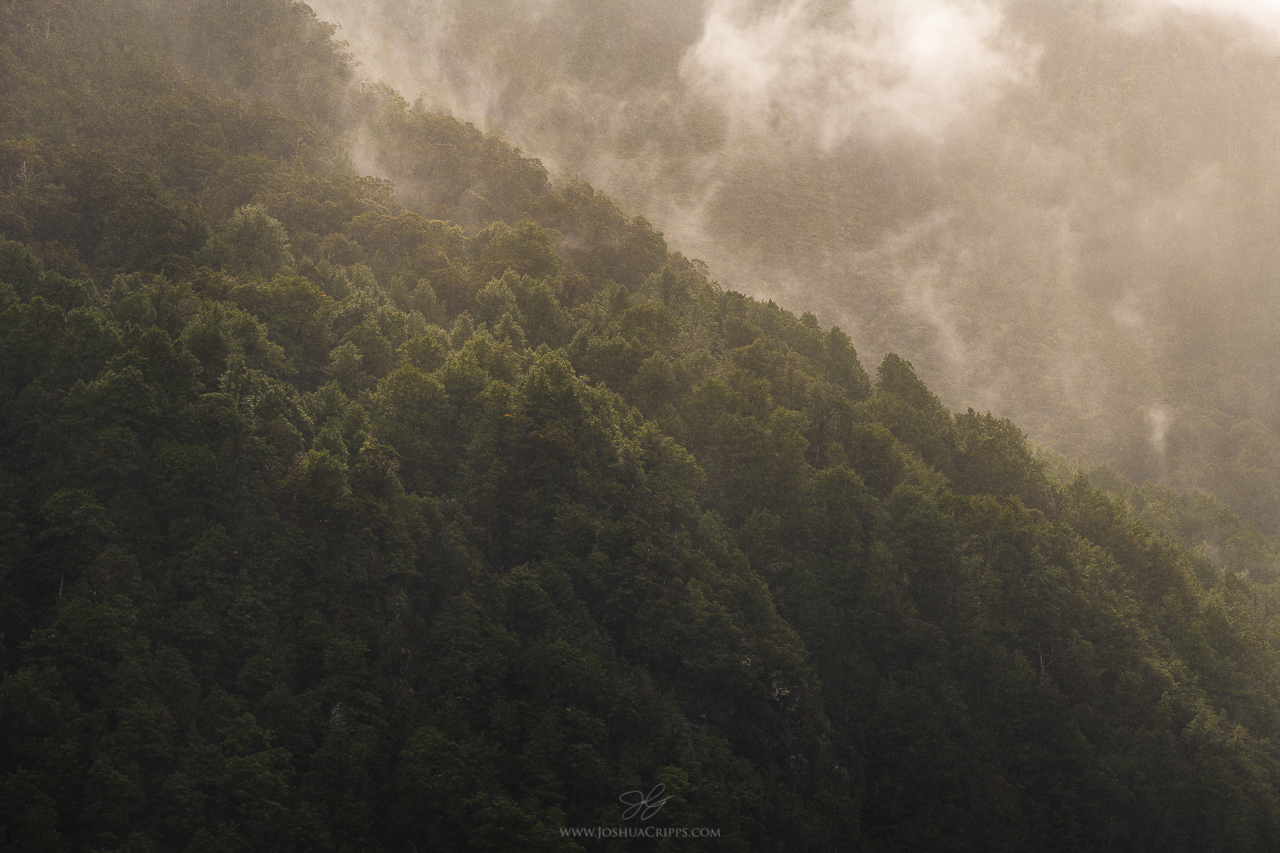
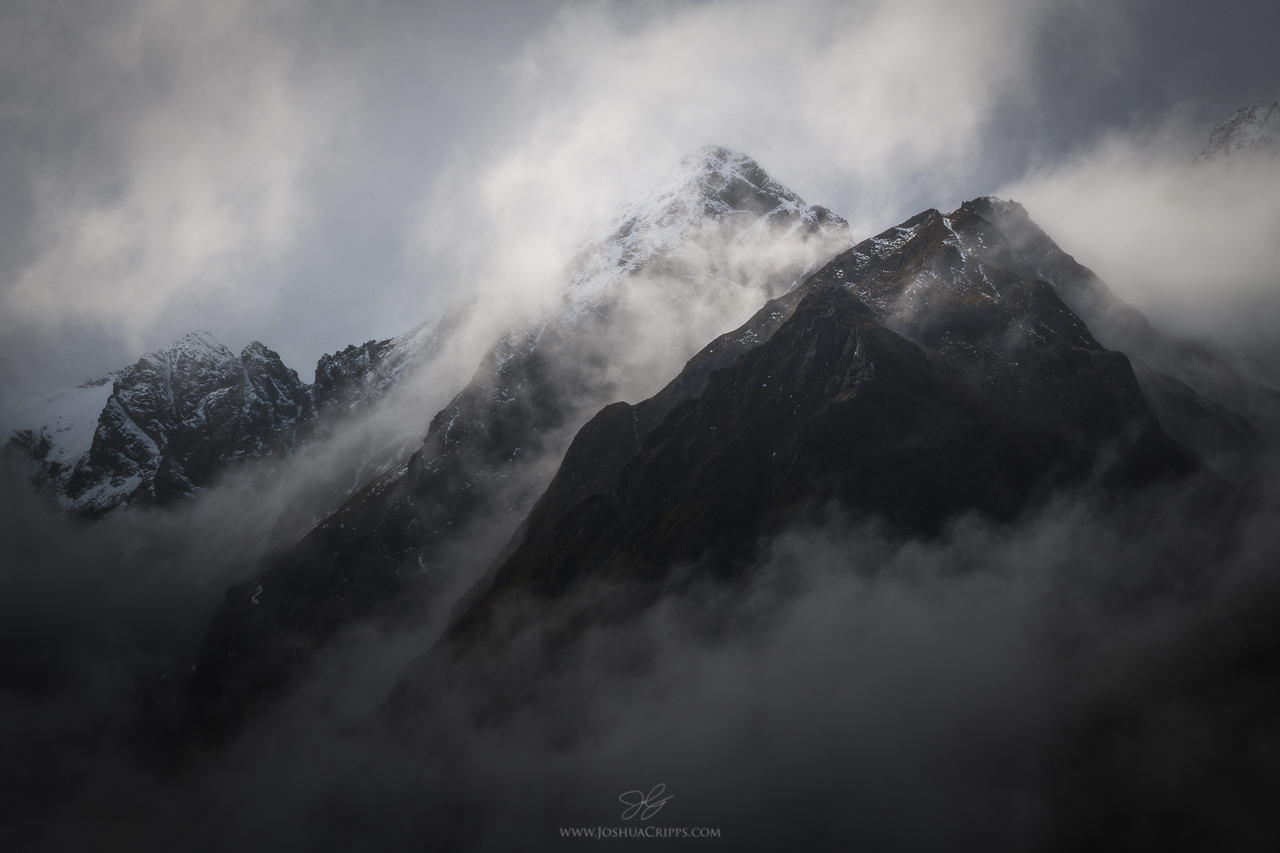
After dark, as I lay in my tent, I thought about the fact that I had never hiked up to the Gertrude Saddle. It’s one of Fiordland’s best day hikes, and in one of those curious displays of coincidence, at least six people in the previous week had told me how much they had enjoyed that particular hike. So before I drifted off to sleep, I resolved to wake up early and hike to the top for sunrise.
Around 3 am, I woke up feeling downright cold, which surprised me as the previous day had been plenty warm, not to mention I was tucked cozily into my sleeping bag. My bladder made itself known, and as I climbed out of the tent to have a scenic whiz, I realized why I was so chilly: the storm had broken completely, and above me were a thousand scintillating points of light. The previous day’s moisture was evaporating like crazy, and the temperature had dropped into the mid 20s. In fact, everything around me, from the grass under my feet to the rainfly over my tent, had frozen solid. I tossed on a layer of long johns and dropped back to sleep.
Before long, my alarm was jabbering in my ear that it was time to get up. Plenty dark and plenty cold outside still, I shrugged out of my bag and into my hiking clothes. I’d already prepped my hiking pack for the day, so it was quick work to jump into the car and head out. Well, it would’ve been, were it not for the fact that the windshield was a solid sheet of ice. I didn’t have any kind of scraper with me, so I grabbed a debit card from my wallet and began hacking away at the ice. After 5 minutes, I had a human head-sized hole cleared in the windscreen, so I popped into the driver’s seat and gunned it out onto the road.
Once the engine was warm, the defroster made quick work of the rest of the ice, and I could drive without squinting through a tiny porthole like a near-sighted sailor. Despite the hour, there was a decent amount of traffic on the road, and I zipped right along with the other cars until I reached the Gertrude Saddle parking lot.
By this point, my car’s thermometer told me the day had warmed up to a toasty -1°C. Thinking about this, as well as all the precipitation from the previous day, I decided I would toss my crampons in my pack just in case. I then set out from the parking lot, getting lost almost immediately. It was still 40 minutes before sunrise and as dark as a cave in winter. And even with my headlamp at max brightness, I couldn’t see the blazes that marked the trail. But with a little deductive hunting, I located one and bombed off down the track.
Despite the cool temps, I was wearing shorts, assuming that some brisk walking would get me toasty in no time. But the Gertrude Saddle track is heavily overgrown, and my bare legs were getting slapped by ice-covered brush with every step. I could feel myself getting colder, so after only two or three minutes of walking, I swapped out my shorts for long johns and overtrousers, then set off again. After only a few more minutes, I came out of the bush and to a river crossing. And though wading barefoot through a snowmelt river in freezing air temps before the sun was even up was not exactly appealing to me, I didn’t want to turn around and stop the hike before I could build any momentum.
Off went the shoes and socks. Plop, plop went my feet into the water. I could feel my toes aching by the time I crossed the 20 steps to the other side, and it was with the utmost relief that I re-donned my merino wool socks and did a few jumping jacks to get my blood pumping to those little piggies.
What this river lacks in size it more than makes up for in coldness.
With all the starts and stops I had given up the idea of getting to the top of the saddle before sunrise. I didn’t think I could even make it by 30 minutes after, when the sun would start to peek into the gigantic Fiordland canyons. So I turned my pace down a notch or 10 and simply enjoyed the stroll up the magnificent valley. A wee while later as I approached the head of the valley I spied a blob of orange on the far side of a wash. At first, I assumed it was a lichen-covered boulder, but as I drew closer and saw black shapes moving around near it, I realized it was a tent, and the black shapes were a couple of campers.
I hailed them, and they called hello back. Taking that as an invitation, I crossed the wash to their camp and struck up a conversation:
“Do you guys know anything about the conditions up on the saddle given the storm yesterday?” I asked.
“Bloody awful!” they (Anita and Tom as it turned out) replied cheerfully. “We went up that way yesterday but turned around because of snow, ice, and crap visibility. So we’re planning to tackle it again today with our mountaineering kit.” And as I watched, they strapped crampons, ice axes, and helmets to their packs.
“Well, I brought crampons, but not a helmet or an ax,” I admitted, “… so do you mind if I accompany you to the dodgy bit, then I’ll make a game-time decision about whether it’s prudent to go on?”
“Sure thing, the more the merrier,” they replied, and so our little trio set out toward the saddle. From their camp, we ascended quickly up the talus and past the signs warning of the exposure and potential danger of the trail ahead.
Above the valley floor we find lots of ice in pools of water.
After 15 or 20 minutes, we came to a small stream that was frozen over in many places, providing a very satisfying ice-smashing opportunity. Crossing the stream and continuing the climb, we found the trail changing character. Large boulders and talus gave way to frozen scree, the small pebbles held in place by the rain and freezing weather overnight. A few more minutes led us to snow, though in the early morning chill, the snow was crisp and high-traction under our boots. Shortly thereafter, we reached the part of the climb where Anita and Tom had turned around the day before. And I could see why:
Above us were a series of granite slabs ascending a broad bowl. The slabs were maybe 10-15° at the bottom, gradually steepening to 25-30° at the top. Every surface was covered with a thick crust of hard ice, along with patches of snow here and there. Down the center of the bowl cascaded a small stream, which trickled over a 100-150 foot drop at the lower edge of the granite slabs. I got the shivers: this was a scene with a high pucker factor, where a slip would surely lead to an uncontrollable slide to a death fall.
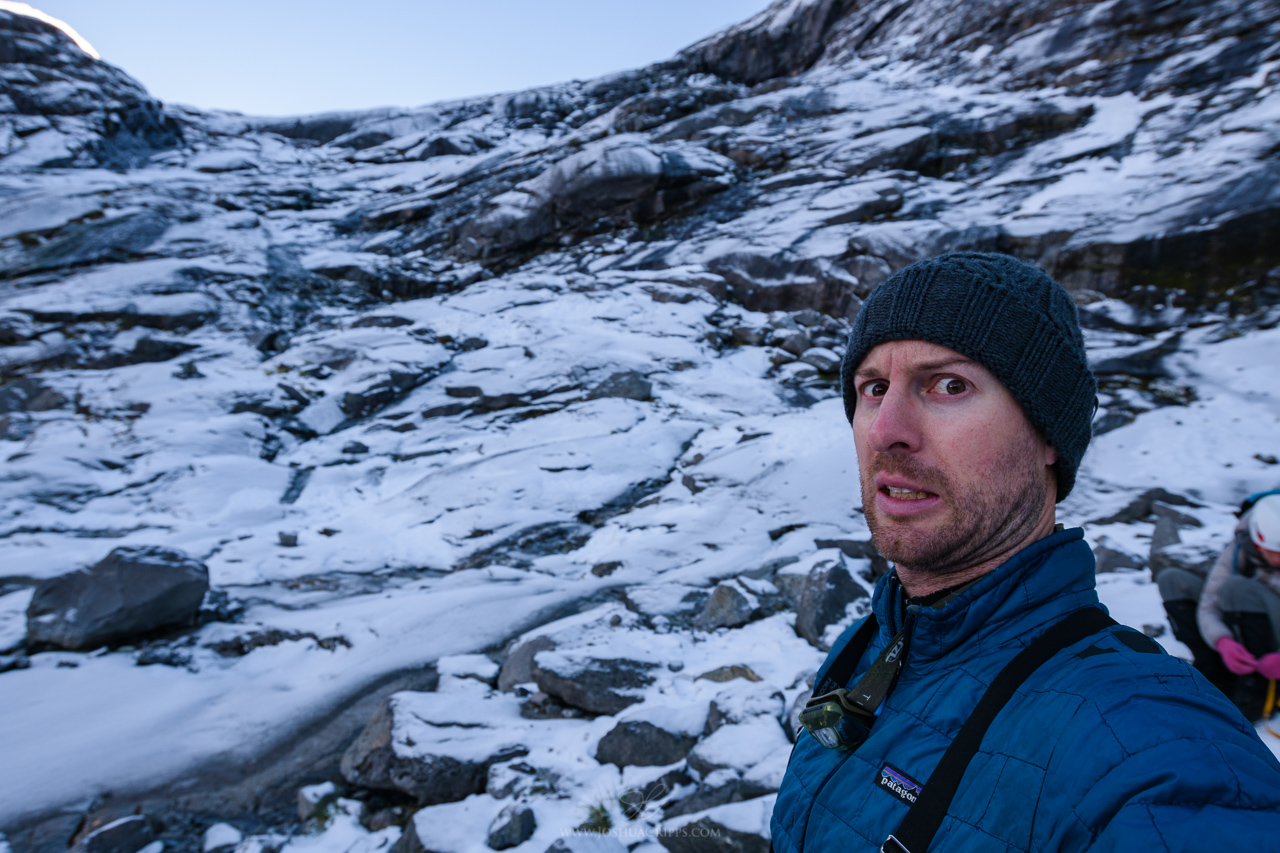
With perfectly clear and calm skies above us, the ice under our feet was the only environmental factor we had to contend with on the climb. So at this point, we donned our crampons and went on a small, safe foray to test them on the thin ice. The steel points bit into the crunchy snow and ice like tiger’s teeth, and we found the walking to be incredibly secure. Nevertheless, we took our time and made each step carefully as we ascended the slabs, simply because of the high consequence of any kind of slip.

At this point, we looked behind us and saw a young backpacker making his way up the start of the slabs, wearing shorts and tennis shoes. He was slipping and sliding with every step, seemingly oblivious to the death fall just below him. We stopped him and strongly encouraged him to turn around, citing our own experiences in the mountains, the fact that he was already slipping and sliding on the ice, the consequences of a fall, the wisdom of living to hike another day, etc. Not even the fact that another young backpacker had died from a fall in this exact spot the previous week dissuaded him. His idiotic response to our recommendation that he turn around: “this is not the first time I’ve walked on snow.”
“You are being really stupid,” we bluntly told him. But as someone who once was a young man, I know that there is no getting through to a young man who is sure he knows everything about the world. So we left him behind as he moved precipitously from snow patch to snow patch, and we crunched our way up easily in our steel crampons.
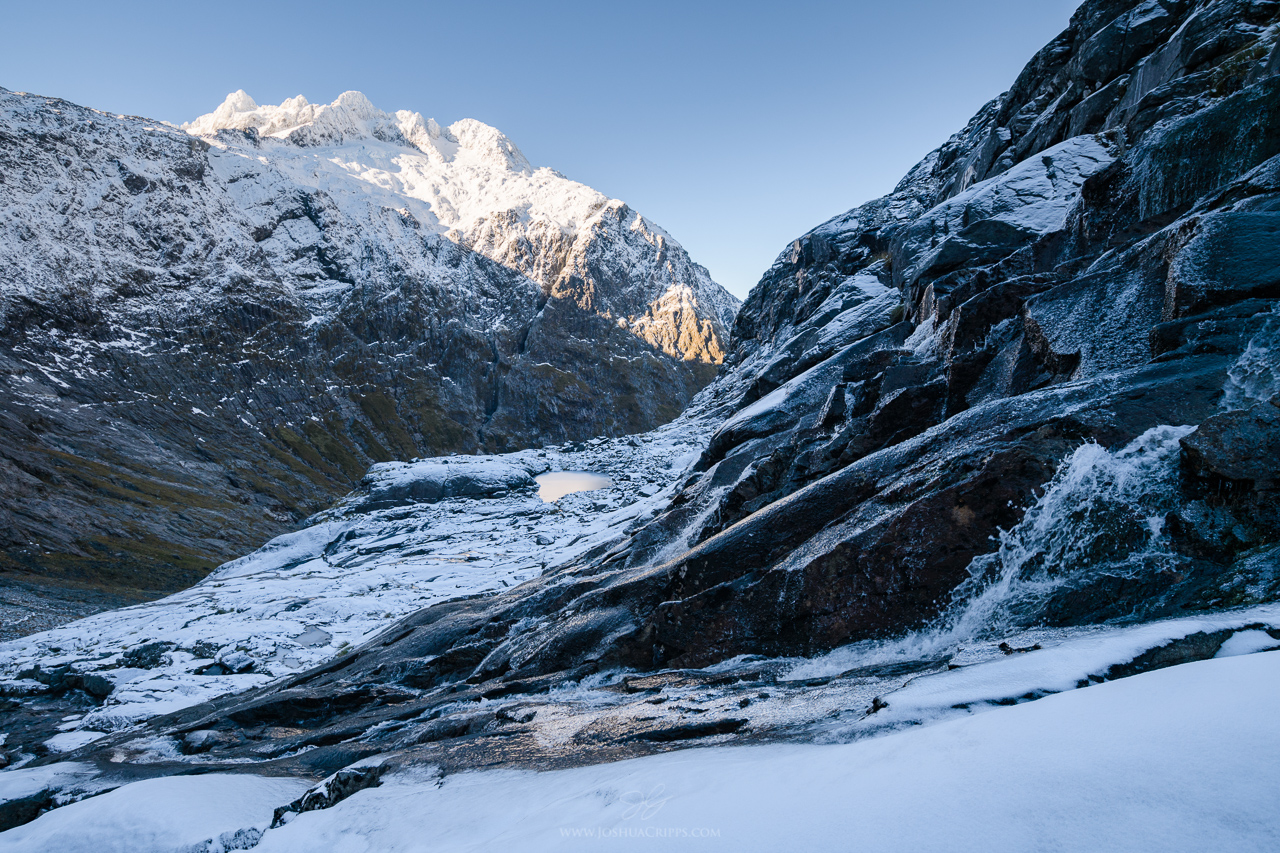
After a few more minutes, we reached the crux of the climb. The top of the bowl had narrowed down to a small gully next to a waterfall, and from there, the route climbed up a series of rocky blocks. Because of the steepness of the climb here, along with the exposure next to the falls, the Department of Conservation had installed a series of cables to help with the ascent. Still, the blocks were completely iced over, and even with our crampons and the cables, we took lots of care to climb this part, as once again, a fall would surely result in grave bodily harm.

The three of us safely reached the top and found ourselves next to a small, mostly-frozen lake, with an extraordinary view of Mt Talbot. We snapped some photos and chatted about the young hiker we tried to turn around. We felt sure he would see the cables, the ice, and the fall and prudently decide to stop. But when we looked back over the edge, we saw that our idiot friend had been joined by another idiot friend, and the two of them were beginning to climb the cables. Not wanting to watch them fall to their deaths, we turned the other direction and started the last short climb to the saddle.

This part was straightforward, lower consequence, and the snow was much deeper. Travel was easy, though we kept our crampons on just in case.
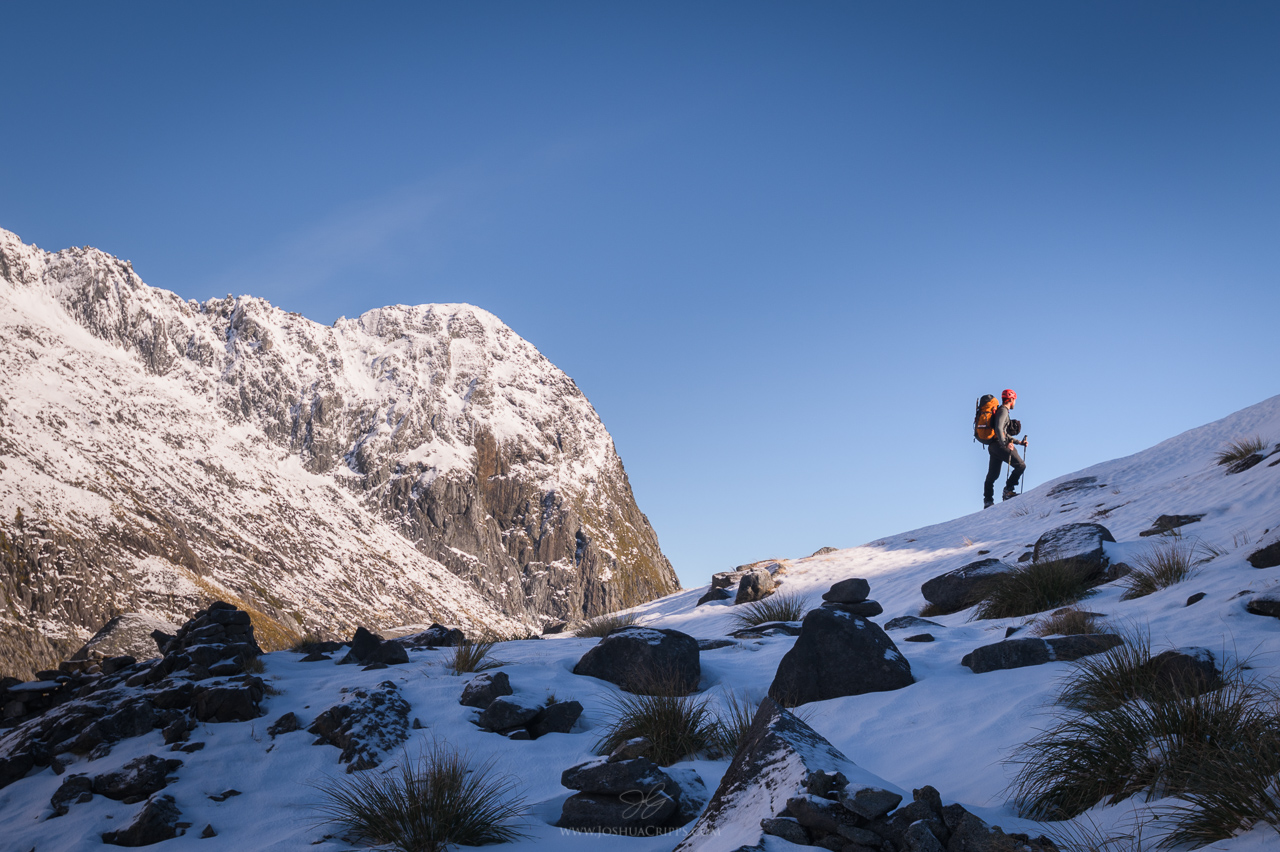
And within a matter of minutes we emerged from the shade into the sun and onto the saddle itself. And from there we were presented with such a magnificent view that my shitty writing skills will fail to do it justice. Razor-backed peaks leaped away from us in every direction, and though we were thousands of feet above the valleys below us the summits of the mountains climbed thousands of feet higher still. To our northwest lay a sheer drop down into Gulliver and Donne River valleys. And beyond that, in the distance, we could see Milford Sound, one of the scenic wonders of the world, with Mitre Peak poking its crown into view. We were buzzed a few times by flight-seeing helicopters and the machines gave a wonderful sense of scale to the scenery.
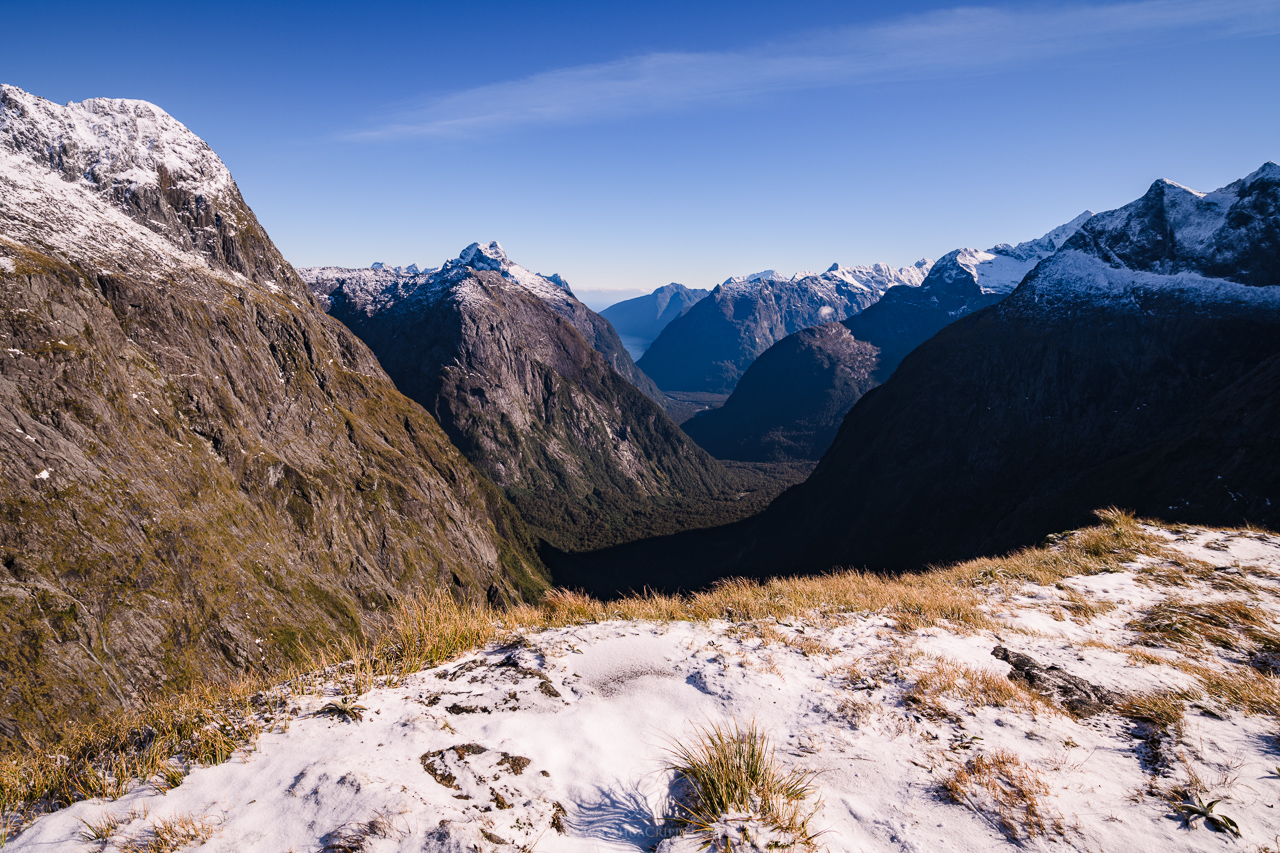
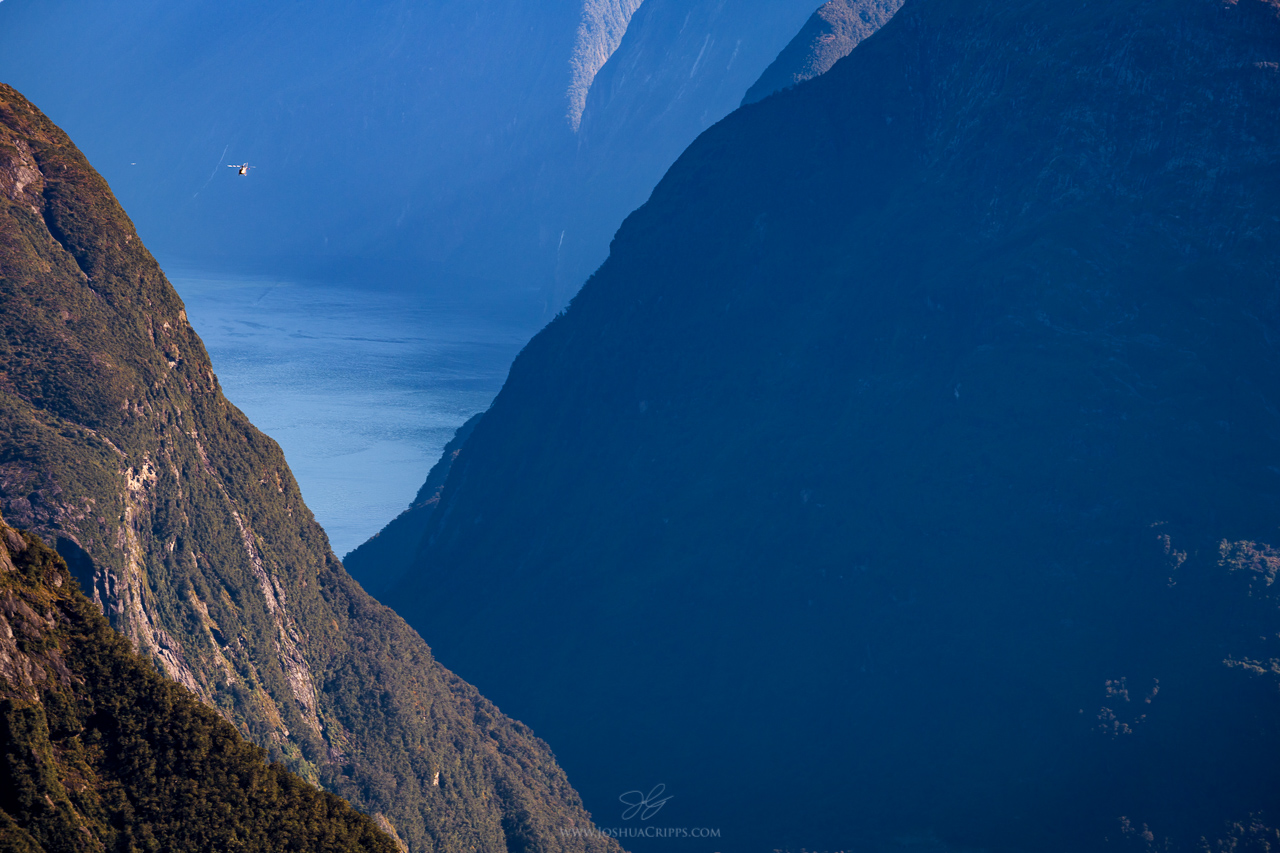
The views in the other direction were no less impressive, with Mt Crosscut rising mightily into the heavens, making an extraordinary contrast to the cobalt sky with its fresh coat of white.

We spent a wonderful 30 minutes on the saddle enjoying the sunshine, the views, and the absurd amount of cookies and chocolate-coated caramels we had individually brought. To our great surprise the two young backpackers made it up all the way to the saddle as well and we congratulated them on their youthful obliviousness as we began our descent. We enjoyed an easy trek back down to the lake below, with outstanding views to guide our way.

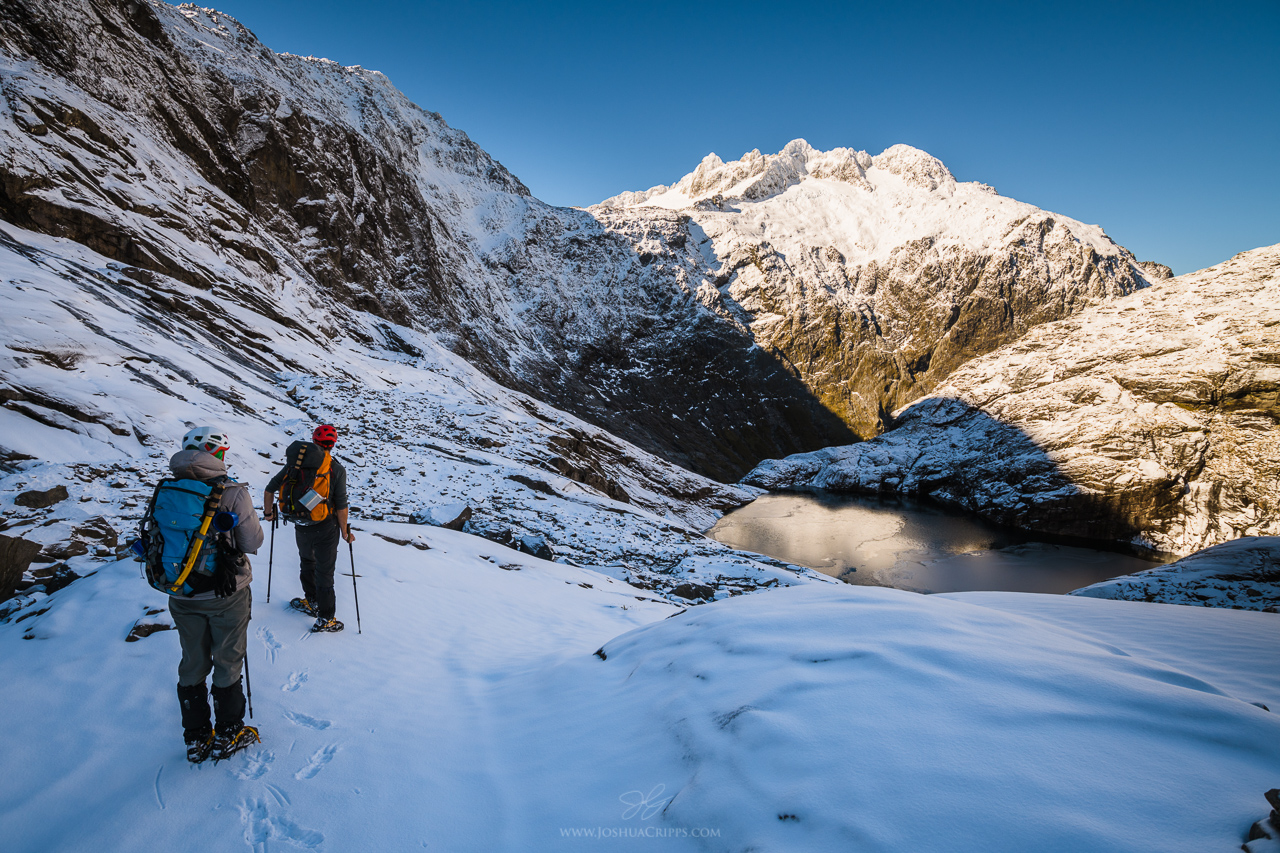
We then enjoyed a careful but easy downclimb on the cables, and a quick final descent across the icy slabs. At this point in the day a number of other hikers were heading up the trail, but we successfully dissuaded all of them from continuing up the ice if they didn’t have crampons. The two young backpackers were not far behind us and I think seeing them lurch, slip, and crab-walk down the ice also discouraged people from going on.
As we descended the trail and ran into more and more people we realized just how under-prepared the average hiker was. When we saw a group wearing nothing but shorts and t-shirts (I don’t remember if they were even carrying water bottles), we just about gave up our crusade to be the trail parents making sure everyone got home safely. Instead everyone got a curt warning: “It’s warm down here in the sun, but up in the shade it’s sketchy and icy. Don’t be dumb, don’t do it.” How many listened, I don’t know.
Back down at Anita and Tom’s camp we changed out of our mountaineering clothing and into comfortable duds. I then bid them goodbye and set off down the trail to the car, enjoying the sunshine and monumental views along the way.
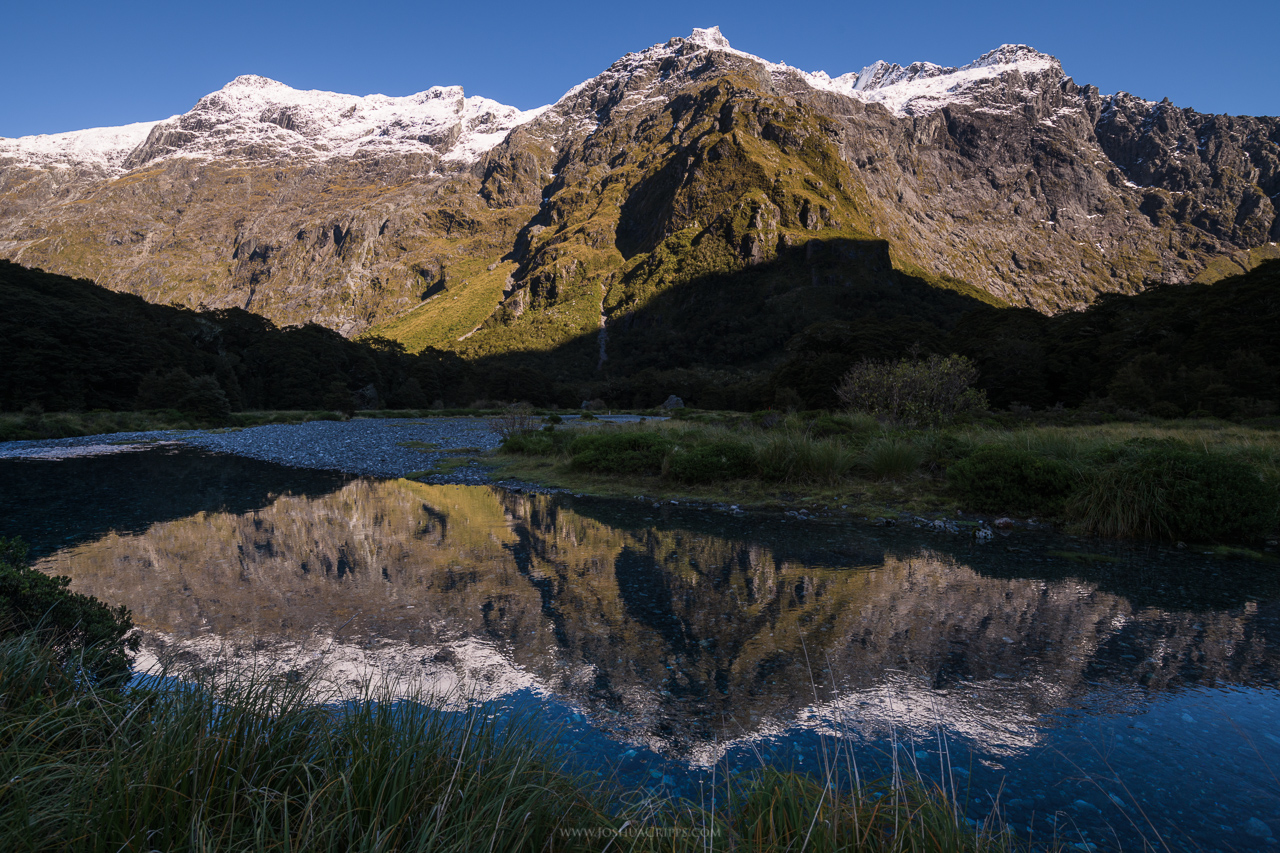
And though I would have loved to have spent the rest of the day wandering around the wilds of Fiordland I needed to get back to Te Anau. A few days earlier I had booked a scenic flight for later that afternoon with Fly Fiordland, hoping to take in the views above Doubtful Sound. Of course, scenic flights are highly weather-dependent and their go/no-go call time for the flight I booked was 3 pm. So I gunned my rental car back to town, arriving back in the land of cell service just as my phone started to ring.
“Hello, this is Daniela from Fly Fiordland. Are you still keen on the flight? Well, the weather is closing in a bit above the fjords so if you want to go come to the airport RIGHT NOW!”
I ripped down the last 20 km to the airport, hastily grabbed a couple of cameras and lenses, and went sprinting into the lobby.
“I’m ready!!!” I cried. “Where’s the plane???”
“Well the plane is ready to go,” replied Shaun, the pilot, “but we’re waiting for a couple of people whose car just broke down.”
Ah, a classic “hurry up and wait” situation. Shaun and I chit chatted for another 20 minutes until his phone rang. The other couple’s car was well and truly hosed, no way they’d make it to the airport. So Shaun hopped in his own car and set out to find the stranded couple who were on the side of the highway about 10 minutes away. And though I was feeling a little irritated that I hurried, hurried, hurried to make it on time and was now subject to a 40-minute delay while the weather continued to close in above the fjords, it turned out that the timing couldn’t have been better.
Once Shaun came back with the couple, we immediately headed out to the tarmac and jumped into the plane. Shaun cranked the engine and we buzzed down the runway and into the sky.
“A storm is continuing to close in about the fjords,” he told us. “So we can expect a little bit of turbulence as we climb above the mountains. And though we’re probably going to see a fair bit of rain on the south side, we’ll look for windows and breaks in the weather and maximize our flying through those.” Then, eyeing my camera gear: “And if everyone is feeling warm enough we can open the windows for a few minutes at a time so you can all get some clear photos, directly out onto the landscape.”
At those words my heart began to pound as I’d always wanted to shoot aerials from a doors- or windows-off flight. Though Shaun did warn us that it would be cold, with an air temperature of around 25°F, plus a 140-mph wind chill. Yeah, brrrrr. And while my heart was thumping hard from the prospect of a windows-open flight, it truly began to hammer as we climbed above Lake Manapouri. The skies had indeed begun to close up and the air was thick with moisture. The late afternoon sun, at this point about 90 minutes away from the horizon, was sending endless crepuscular rays through the sky to interact with the landscape in a dance of light and shadow. We threw open the window of the plane, the cockpit flooded with frigid air, and I hammered my shutter button as fast as possible, a gigantic smile plastered on my face.
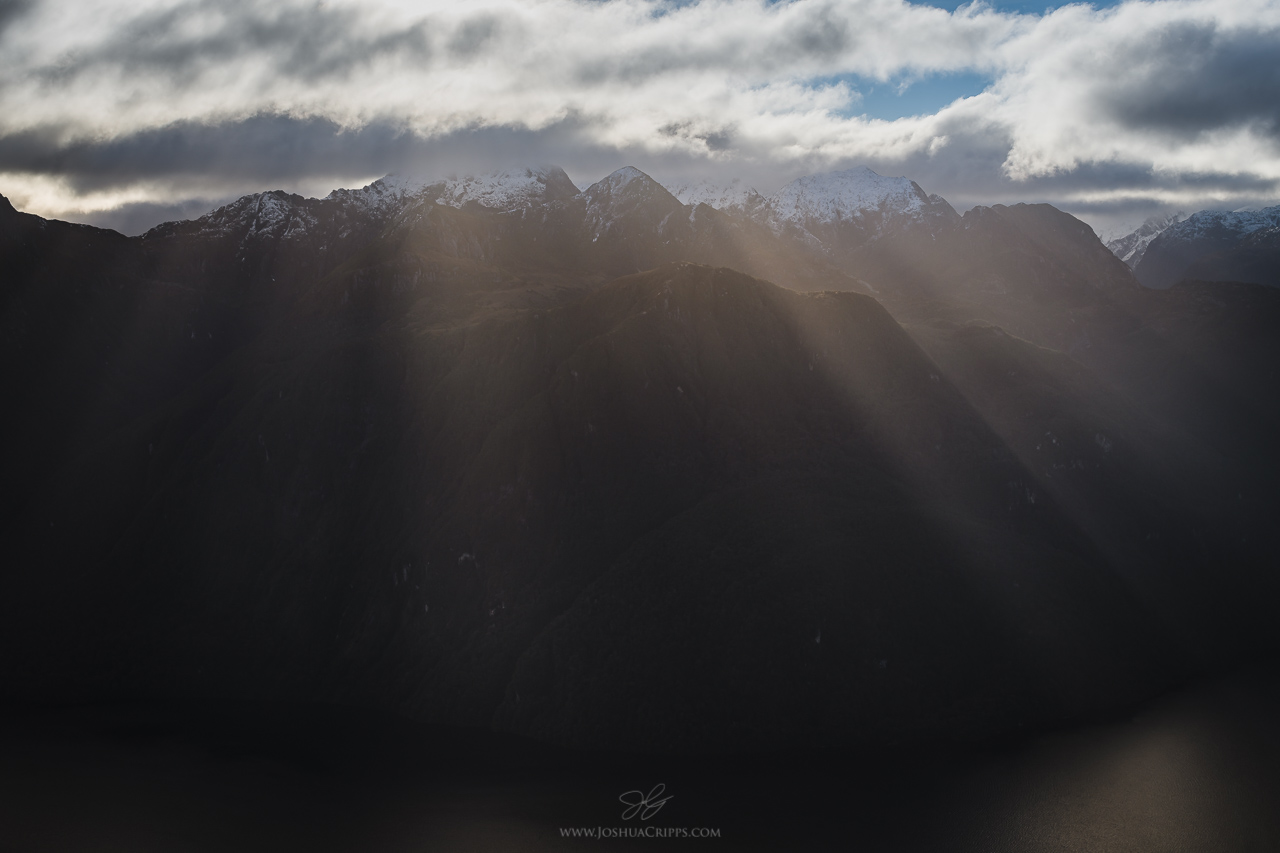
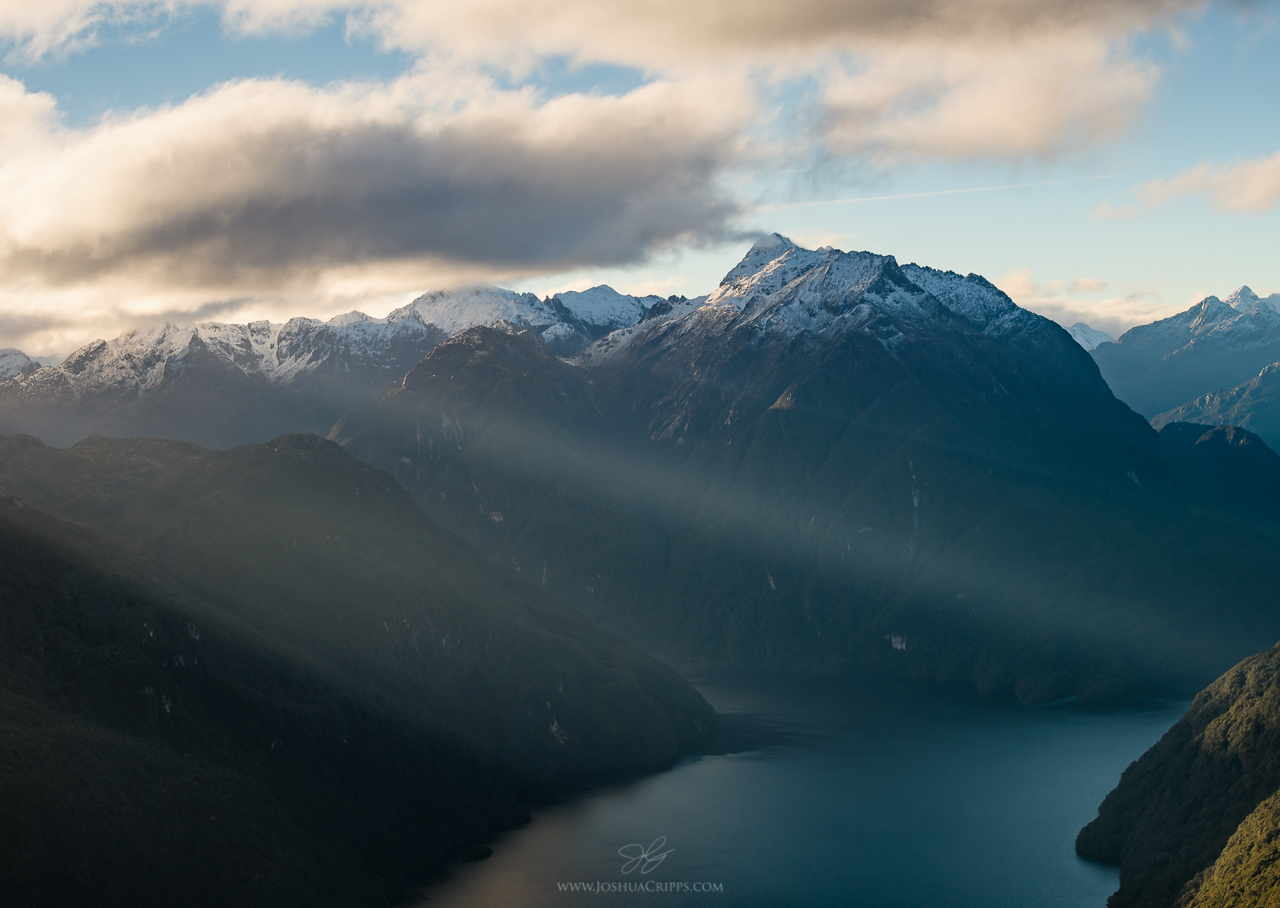
We flew southwest for a few minutes then turned north and encountered thickening rain as we buzzed our way up a valley toward Mount George. And though the window was closed again at this point our mouths were hanging wide open as we cruised above tiny lakes nestled high in the mountains, each drained by its own 2,000-foot waterfall. We crossed a pass and turned westward, flying directly to Doubtful Sound (and temporarily out of the rain). We emerged over the fjord above Elizabeth Island, and here I saw something I’ll remember for the rest of my days: Doubtful Sound was almost as calm as an alpine lake at dawn and was reflecting the patterns, textures, and colors of the clouds above. Long, sinuous waterfalls snaked down the mountainsides, and distant rain and moisture gave the view a mystical atmosphere. The sun painted the scene with wine-colored notes, and off toward the horizon more crepuscular rays punched through the clouds to hit the water below. I even spotted the Fiordland Navigator, giving its complement of passengers a surely magical experience as it plied the waters of Doubtful Sound.
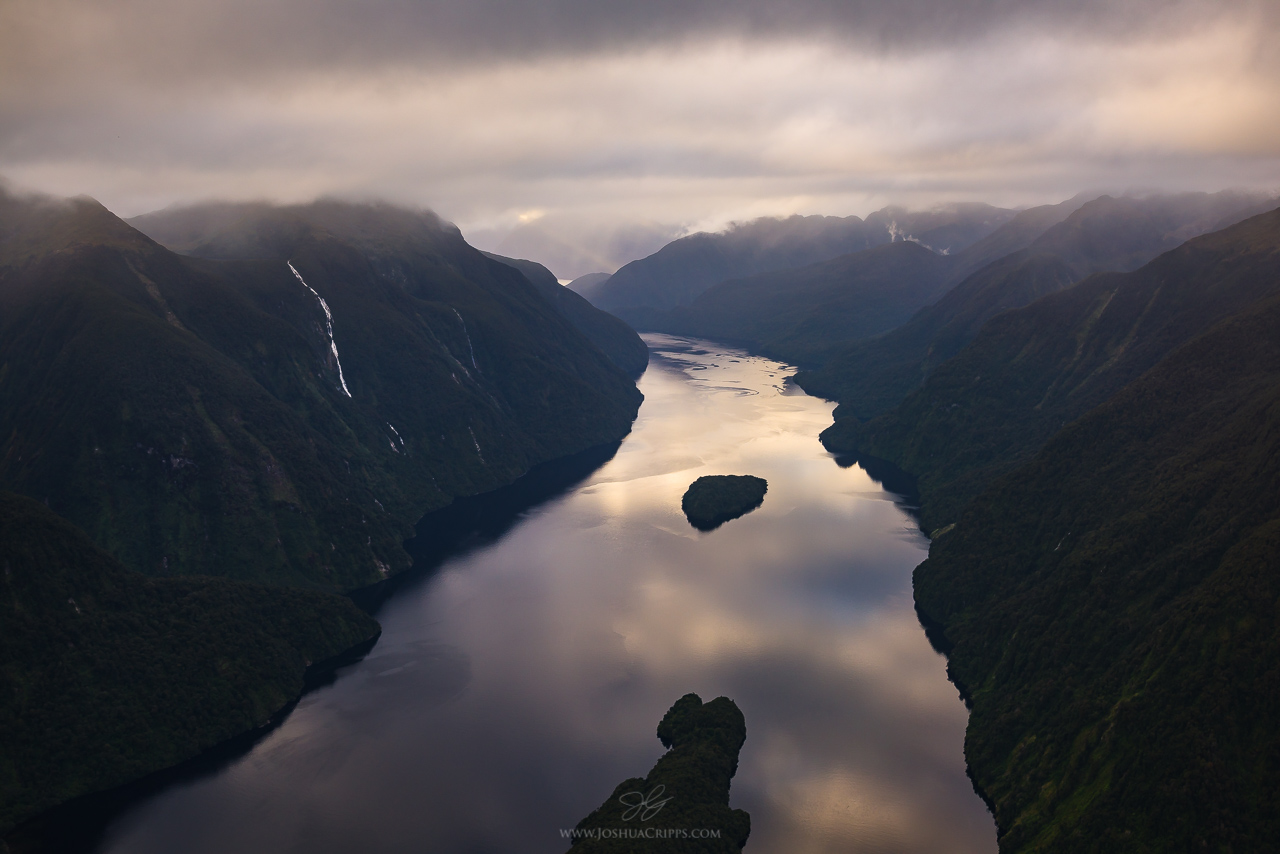
Shaun then took us on a zig-zagging course up the fjord and out to the Tasman Sea. And with every subsequent swoop I threw the window open and whooped and hollered as I rattled off frame after frame.

From the Tasman, we curved back along Bradshaw Sound and up Cozette Burn before turning back toward the Te Anau airport. I got in one last view of the fiord and popped my camera out the window (while holding it in a death grip so as not to lose it to the 140 mph winds) for a final shot as Doubtful Sound was lost to view.

A few minutes later, we were landing back on the runway with grins stretching each of our faces wide, entrancing images seared into our memories, and billions of beautiful pixels burned into our memory cards. My dopamine levels were soaring, and I was ready to book out the entire plane for another trip around, but the weather was getting worse, and the sun was just about to set. So instead, I gathered up my gear and headed back to my car, awash in high emotions, and excited for my next opportunity to fly through such grandeur.
In fact, as darkness fell and I drove to my hotel for the night, I reflected on the previous two days and felt a deep sense of gratitude for one of the most beautiful 48-hour periods of my life. New Zealand is full of magic, and I felt incredibly fortunate to have experienced so many deep breaths of it during those days.
~ Joshua


15 Responses
Hi Josh,
Is the country accent newly acquired? I saw some how to tutorial videos where you had no accent at all. But recent 2017 trip to King’s Canyon video you have a heavy accent. Just curious. Does impact my desire to see and enjoy your work. You are very talented.
It’s a long-running joke. Whenever I wear that particular hat I channel a character named Shorty Harris, famed for his east Texas accent and country colloquialisms. 🙂
fantastic story telling. I could almost imagine I was there… except I would never have hiked in the ice and taken off my shoes and socks to walk through that river. did you have watersheds to avoid slipping? Fabulous images. I imagine some of the sound might be wonderful on metal.
Hi Sara!
Thanks so much for your comment. I did have crampons for walking on the ice so my footing was actually quite secure. I wish I could say the same for the idiots who followed us up in their tennis shoes. Jeez Louise. 🙂
And yes, I would love to make some prints from this adventure. Don’t have the wall space in my cabin at the moment though!
Take care,
Josh
Another good reading Josh on your New Zealand trip. Fun, funny and adventurous. Your images are beautiful!
My partner is a Kiwi and we traveled through Milford Sound on a cruise ship a few years ago. It is an eerie place and you would have probably captured much better photos that we ever could. NZ has some majestic places to visit.
Hi Kath,
For me Milford is not so much eerie as it as a great reflection of the weather it’s experiencing. I’ve certainly seen it in gloomy, eerie storm conditions, but also in jubilant bright, sunny days. Regardless it’s an extraordinary place!
All the best,
Josh
The story telling is as gripping and compelling as the photographs. What an adventure Josh!
Thanks, Graham! Glad you enjoyed it, and hope everything is well.
Marta and I were up there for sunrise too, it’s hella pretty and we had a very similar experience to you minus the snow. Lots of big groups completely unprepared, shorts, plimsoles and nothing for emergencies. It’s a huge shame about the unnamed 28 year old tourist and you did the right thing about telling everyone going up what the conditions are like. If you are like me then sometimes you feel a bit of a know-it-all knobhead but at the end of the day, our conscious is clear. I have to always remind myself that what they do after is out of my control. Anyhoo, you’ve taken some awesome shot as per, keep the posts coming 🙂
Yo Jack, well said. There’s only so much you can do to make sure everyone else is well prepared. I’m sure DOC is going through a zillion different kinds of reviews right now to figure out how they can better inform people about conditions so that there are fewer incidents on their managed lands. I’m not sure you will ever reach some people though. We recently had an incident here in California where a hiker used his PLB to call a helicopter because he was tired. Then waved the helicopter off when it actually arrived and hiked down the rest of the way himself. Huh.
An amazing 48 hours indeed … Wonderful images! My daughter spent some time traveling around NZ and absolutely loved it. Hope to get there one day myself.
Thank you, Ingrid! NZ is a must visit and I hope you do get over there soon.
Cheers,
Josh
Joshua,
Great pictures! Having visited the same area in NZ I perfectly understand your feelings about the area. Also, with this post I realized that my travel blog is not a waste of time. Thanks for sharing!
Hi Glidden,
Glad you enjoyed it. And you should definitely keep up the travel blog; it’s a wonderful way to express yourself and share your experiences with loved ones.
Cheers,
Josh